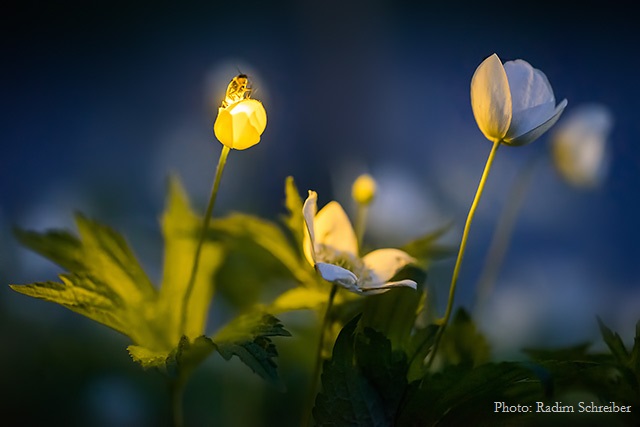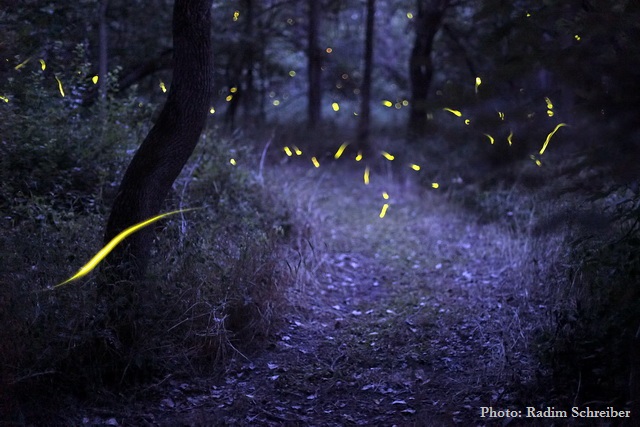
Firefly Illuminating Wood Anemone Wildflower – see more beautiful images at The Firefly Experience
“IN HER FLOWY NIGHTGOWN AND BARE FEET, SHE RUSHED HEADLONG INTO THE SUMMER NIGHT TO WITNESS ONE OF THE MOST MAGICAL DISPLAYS OF NATURE – A FIELD OF FIREFLIES!”
One of my most treasured memories from a childhood in Maine is watching those magical “lightning bugs” or fireflies light up a field at night.
I remember how comforting it felt to have the emptiness of an ink-black night interrupted by the fairy-like twinkling of countless fireflies announcing their place in the world.
The Sense of Awe and Wonder.
The trance of the dancing lights, just out of reach – almost beyond the veil of this world.
And then, of course, if you were lucky enough you would capture one and marvel at the bottled magic in a jar beside your bed as it hypnotized you to sleep (the poor things, imprisoned in glass).

In my adult years, I’ve noticed far fewer of these enchanting insects enhancing our summer nights. A lot of my friends and family have made the same observation.
This is why I was so happy to see a good, respectable number in our small meadow the other night. My 9-year daughter, offspring to not one – but two biologists – is following in her parent’s footsteps already.
She has a deep fascination with all things wild.
Needless to say, she was delighted with the chance to postpone bedtime and to explore a new natural wonder with Mama when I called inside: “Honey! Come out and see all the fireflies!!”
In her flowy nightgown and bare feet, she rushed headlong into the summer night to witness one of the most magical displays of nature – a field of fireflies!
We crouched down on the edge of the driveway and watched their lights, flashing across our tall grass and bushes.
We held hands and whispered and watched. It was a moment I’ll never forget.
So, what’s changed?
Why are so many of us seeing fewer fireflies?
A lot of it has to do with habitat loss caused by increased development and our American obsession with massive lawns and “tidy” landscapes.
In our case, we are seeing more fireflies because we’ve recently let parts of our lawn “go”. We even had a neighbor ask us the other day, “do you guys even mow?!”
In some places we do, in others we only mow once a year.
In one of our low-mow areas we now have a lovely little meadow under our apple trees that, despite its small size, is delivering big rewards.
We enjoy the blooming wildflowers by day and the tall vegetation supports more fireflies for us to enjoy at night.
What can YOU do to attract more fireflies to your yard?
Five Easy Ways to Create Firefly Habitat
1) Let it Grow & Create Cover
Allow areas of your lawn or landscape to go wild. The tall grass and plants that develop there will provide “cover” for fireflies during the day when they are inactive and resting, and need to avoid predators. You can mow these areas late in the season, once a year (hallelujah: less work!). Shrubby/brushy edges along your woods are also good. Fireflies prefer moist areas and thrive in wet meadows, bogs, marshes, and wetland edges, so try to select moister sites for enhancing habitat.

2) Avoid Chemicals & Let Them Live
Don’t use chemicals on your lawn/yard. Many products marketed for our lawns/yards are insecticides designed to kill insects (because some of them are considered “pests”) but these chemicals don’t discriminate and can kill fireflies too. Many organic solutions exist for common pest problems.
3) Go Dark & Let Their Light Shine
Artificial lighting has negative effects on fireflies (and moths), so make sure if you have a porch light it’s on a motion sensor and there are minimal lights polluting the dark night. Natural darkness will attract them to your space because they are free to communicate with one another via bioluminescence.
4) Leave Debris – Let It Be
We may have 20-30 different species of fireflies in New England, and many of these need downed woody material like rotten logs and fallen tree branches or leaf litter to complete their life cycle. Resist the temptation to “clean up” your wooded edges and forested areas and you’ll be providing habitat by doing literally nothing!
5) Embrace Slime So They Can Dine
Like many insects, fireflies undergo a metamorphosis. In their larval form, they feed on grubs, snails, slugs, and worms. They need this food in order to become the beautiful adult fireflies we all love to see. Who knew that slime could be at the root of such beauty?! Allow some of these slimy creatures to live on your landscape, while enjoying the service larval fireflies provide by preying on common garden pests like slugs and Japanese beetle grubs.
Did you know? Fire “flies” are actually not flies at all, but winged beetles in the family Lamphyridae (note the root word “lamp”, from the Greek word lampein, which means “to shine”).









Thanks for info on, as we call them, lightning bugs. Grew up with them every summer and wondered where they had gone. I have always believed in let it rot
as it becomes forest floor, and no chemicals but didn’t think about the lighting as we have a long path to the camp. Saw some bugs the other night and was thrilled so will be turning off outside lighting starting tonight.
For the first time, fireflies are abundant in my Maine garden. For the past 20 years, I have had no more than a couple. Prior to that, I never saw any. I am so thrilled
Getting worried. I thought I’d see them now that it got warm, but they aren’t out. I usually have hundreds in my little patch of unmowed haven in suburban yuck.
Thanks for your post. I’m pressed against the doors to the deck watching the fireflies emerge for an evening of frolic here for in downeast Maine. It’s a sight we never tire of. Once we stopped putting out numerous solar lights the number of fireflies increased!